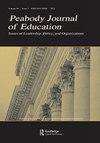Do Districts Using Weighted Student Funding Formulas Deliver More Dollars to Low-income Students?
Q2 Social Sciences
引用次数: 3
Abstract
ABSTRACT School districts have increasingly adopted weighted student funding (WSF) formulas that allocate dollars, rather than staff positions, to schools in the name of equity and flexibility. While research to date has studied equity in some of these districts, there is no research that examines the entire cohort of WSF districts together. This paper examines how equitably 20 WSF districts distribute dollars to their schools measured against a cohort of 20 comparable districts that use a traditional, centralized staffing model. We find that while a majority of all 40 study districts drive more dollars to low-income students, low-income students in WSF districts are more likely than their peers in other districts both to receive additional dollars and to receive a greater share of district expenditures. We also find that WSF districts that have had their formula in place for longer are more equitable than recent adopters.使用加权学生资助公式的学区会为低收入学生提供更多美元吗?
学区越来越多地采用加权学生资助(WSF)公式,以公平和灵活性的名义为学校分配资金,而不是员工职位。虽然迄今为止的研究已经研究了其中一些地区的公平问题,但还没有研究将整个WSF地区放在一起进行调查。本文考察了20个WSF地区如何公平地分配资金给他们的学校,并与20个使用传统的集中式人员配备模式的可比地区进行了比较。我们发现,虽然所有40个研究区中的大多数都为低收入学生提供了更多的资金,但WSF地区的低收入学生比其他地区的同龄人更有可能获得额外的资金,并获得更多的地区支出份额。我们还发现,长期采用其公式的WSF地区比最近采用公式的地区更加公平。
本文章由计算机程序翻译,如有差异,请以英文原文为准。
求助全文
约1分钟内获得全文
求助全文
来源期刊

Peabody Journal of Education
Social Sciences-Education
CiteScore
2.20
自引率
0.00%
发文量
43
期刊介绍:
Peabody Journal of Education (PJE) publishes quarterly symposia in the broad area of education, including but not limited to topics related to formal institutions serving students in early childhood, pre-school, primary, elementary, intermediate, secondary, post-secondary, and tertiary education. The scope of the journal includes special kinds of educational institutions, such as those providing vocational training or the schooling for students with disabilities. PJE also welcomes manuscript submissions that concentrate on informal education dynamics, those outside the immediate framework of institutions, and education matters that are important to nations outside the United States.
 求助内容:
求助内容: 应助结果提醒方式:
应助结果提醒方式:


